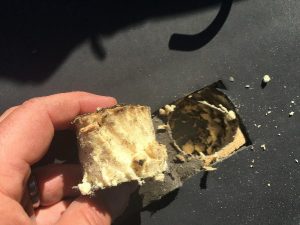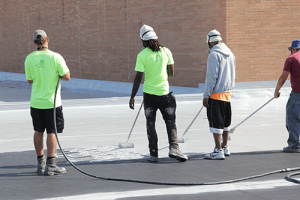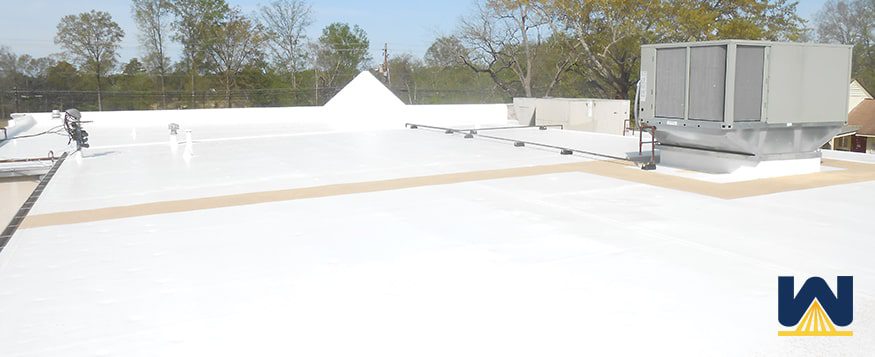If you’re a commercial building owner, you want your roof to last as long as possible. The easiest way is to restore your roof by making minor repairs and then adding coating over your existing roof.
In this article, we’ll explain:
- A typical scenario a building owner faces when thinking about roof restoration?
- What is the protective coating?
- What commercial roofs are qualified for a coating system?
- The process of how the coating gets applied to your existing roof system
- What benefits does the coating provide?
- How much longer will the coating make your roof last?
West Roofing Systems has been known for installing spray foam roofs since 1979. The coating is used to protect spray foam roofs, but it’s also used to preserve and restore other roofing systems as well.
Using a coating to extend the life of a commercial roof is known as a silicone restoration membrane system.
Let’s get started!
How does a roofing conversation start?
A building owner will experience a problem. Usually, a tenant will file a complaint that the roof is beginning to leak or that there are brown spots on the ceiling.
Suppose the building owner doesn’t have a service contract or a warranty with a roofing contractor. In that case, they will need another roofing contractor to look at the roof.
Once an experienced roofer gets on the roof, they will:
- see where the problem areas are
- investigate water entry points
- possibly pull core samples
- and then perform an infrared inspection to determine the amount of water saturated in the insulation.

Once all the data is collected, the building owner can make the best decision for their roofing problems.
A silicone restoration system can be performed if the roof has less than 25% saturation.
If the roof is more than 25% saturated, it may be more cost-effective to completely tear it off and install a new system.
What is the protective coating?
The protective coating that increases the life of an existing roof is silicone.
Silicone is applied similarly to paint, except it’s designed for commercial roofing systems.
The best characteristic is that silicone is waterproof, which will not break down with water, and will not let water pass through into the insulation of your roofing system.

Silicone comes in various colors, but the most used colors are white and gray. These lighter colors reflect (instead of absorbing) sunlight to keep the roof cool.
On a 90-degree day, a roof with silicone coatings may only be 5 degrees warmer than the outside temperature.
If the same roof had a black roof, the temperature would likely exceed 150 degrees.
This makes your HVAC unit work harder to combat the hot air entering your building.
Typically, the energy savings of installing a silicone roof versus a darker roof is 15-35%.
Here’s a video from the Department of Energy explaining cool roofs and energy savings:
What commercial roofs are qualified for a coating system?
Unfortunately, not every roof can get silicone coating installed.
Commercial roofs need to:
- Have seams that are in good condition
- Have less than 25% saturation in their insulation
- Have had a service/maintenance contract over the roof’s lifetime
Seams that are in good condition
A roof with seams completely ripped apart and losing adhesion is not a good candidate for a roof restoration. The reason is that if the seams are ripped apart, there is a large area for water to enter the insulation.
Less than 25% saturation
An infrared inspection will identify where water is present underneath the top layer of a roofing system. Suppose more than 25% of the roof is saturated. In that case, it may be a better long-term play to replace the entire roof instead of restoring it with a silicone coating.
Had a service/maintenance contract
A commercial roof with routine maintenance will most likely be in good shape. Service contracts include:
- Identifying small holes and cracks and fixing them.
- Cleaning out the drains to prevent standing water.
- Adhering seams back together if adhesion is lost.
All of these repairs keep the roof in good condition, which means it will be cost-effective to restore in the future..
How does the coating get applied to your existing roof?
Here’s a video of a silicone restoration membrane being applied to an existing roof:
The first step is to clean the existing roof, which is done with power washing.
Once all the contaminants are removed from the roof, the next step is to remove and replace any saturated areas.
An infrared inspection will identify these saturated areas.
A similar roofing material will replace the saturated areas. For example, if TPO and Polyiso insulation are removed, brand new, dry, TPO and Polyiso will be installed on the roof.
Now that the entire roof is dry and clean, the next step is to treat the seams (if there are seams on the roof).
Seams are treated in one of two ways:
- Install a wet-out coat of silicone over the seams (usually 12 inches wide), then embed a polyester mesh into the wet-out coat, then let the area dry overnight.
- Install a butyl-backed, self-adhering tape overtop of the seams.
Once the seams are treated, the silicone coating will be installed over the entire roof in one or two coats. The coating thickness determines the warranty length.
NOTE: If you’d like more detail on the process of a silicone restoration system, we made a 9-minute video:
What benefits do silicone roof coatings provide?
There are plenty of benefits of a silicone roof coating system, including:
- Reduced material cost
- Reduced labor expense
- Reduced landfill contributions
- Reduced energy cost
Reduces material cost
Instead of replacing the entire roof, only the saturated materials are removed and replaced. Only paying for the materials of 25% (at most) of a roof instead of 100% is a significant cost saving.
Reduces labor expense
Without removing everything off the roof, labor costs are significantly reduced. Also, the silicone coating is easy to install, which reduces the total installation time versus any other roofing system.
Reduces landfill contributions
With only the saturated areas being removed instead of everything off the roof, the amount of materials transported to landfills is minimal. This also saves transportation costs to get those materials to the dump.
Reduces your energy cost
A white roof versus a darker roof reduces energy savings (on average) by 15-35%. The #1 factor is that a lighter roof reflects the sun rather than absorbing it as a darker roof does.
Higher roof temperature = a warmer building = more work for your HVAC unit = higher energy costs.
How much longer will silicone coatings make your roof last?
Manufacturer warranties come in 10, 15, and 20-year options.
- For a 10-year warranty, 20 mils of silicone will be installed.
- For a 15-year warranty, 25 mils of silicone will be installed.
- For a 20-year warranty, 30 mils of silicone will be installed.
Each option differs in cost.
The longer the warranty, the more coating that’s installed, and the more it will cost.
You may wonder if a silicone coating system is best for your commercial roof.
The best thing you can do is to get the opinion of a few roofing contractors and see what options they give you.
The thing with roofs is…there is no set correct answer. The best roofing option depends on the current condition of that individual roof.
- Some roofing contractors will only propose a complete tear-off.
- Some might offer you a silicone restoration system.
- Some might provide a repair for what you already have and tell you the roof will last 5 more years.
It’s essential to understand the “why” in their roof proposals.
Why can I get away with a repair, and the roof will last for 5 more years?
See how the contractor backs up their claim, and then choose the option you trust the most.
West Roofing Systems has given building owners multiple options to fix roofing issues since 1979. And we always justify the best roofing option for your building with photos, infrared inspection reports, walking the roof with you, and much more.
Want to learn more about silicone restoration membranes?
The silicone roof coating cheat sheet discusses:
- Cost per square foot
- Common problems the system can have
- What benefits the system offers building owners


